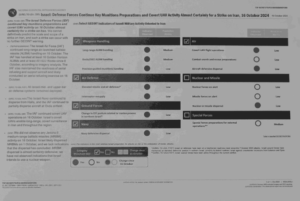From Nonprofit to For-Profit: The Financial Necessities and Strategic Shifts in AI Development
The transition from nonprofit to for-profit AI has become a crucial strategic move for many organizations aiming to scale their operations and impact. This shift is primarily driven by the need for vastly more capital than initially anticipated to keep pace with the rapid advancements in artificial intelligence.

In the rapidly evolving world of artificial intelligence (AI), the transition from nonprofit to for-profit organizations has become a pivotal topic. This shift is not merely a change in structure but a reflection of the financial and strategic necessities that drive AI research and development. The move from nonprofit to for-profit in AI underscores the need for vast capital, scalability, and the balance between innovation and regulation. This article delves deeper into why this transition is essential, its implications, and how it shapes the future of AI.
Table of Contents
The Financial Imperative for Transition
The primary driver behind moving from a nonprofit to a for-profit structure in AI development is the need for substantial capital. Nonprofit organizations often face significant funding limitations, which can hinder their ability to scale and innovate at the pace required to stay at the forefront of AI research. For instance, OpenAI, a leading AI research lab, initially started as a nonprofit but later transitioned to a for-profit model. This decision was largely driven by the realization that scaling AI research to meet future demands required resources beyond what they could attract as a nonprofit.
Scaling AI research involves extensive computational resources, talent acquisition, and infrastructure development. These elements require continuous and significant investment, which is more feasible under a for-profit structure that can attract venture capital, private equity, and other investment forms. The ability to generate revenue and reinvest in research creates a sustainable model for long-term innovation.
The Role of Government and Society
While for-profit entities can drive rapid innovation, the role of government and society in setting regulations and ensuring equitable AI development is crucial. Governments have historically played a significant role in regulating industries to ensure safety, fairness, and public good. The aviation industry is a prime example, where stringent regulations have led to remarkable safety standards. Similarly, in AI, government regulations can help mitigate risks and ensure that AI technologies are developed and used responsibly.
However, there is a debate about whether governments alone can lead AI development effectively. Governments have the capability, as seen in large-scale projects like the Apollo program. Yet, the agility and innovation speed in the private sector often outpace government-led initiatives. Therefore, a partnership between for-profit entities and government agencies is essential. This collaboration can leverage the strengths of both sectors, combining the innovation drive of private companies with the regulatory oversight of government bodies.
Balancing Innovation and Regulation
A critical aspect of AI development is finding the right balance between innovation and regulation. Too much regulation can stifle innovation, while too little can lead to unintended consequences, such as ethical violations and safety risks. The challenge lies in creating a regulatory framework that supports innovation while ensuring that AI technologies are safe, fair, and beneficial to society.
Involving various stakeholders, including AI developers, policymakers, and the public, in the regulatory process can help achieve this balance. For instance, engaging in dialogues about ethical AI, data privacy, and algorithmic transparency can lead to more informed and effective regulations. Additionally, regulatory bodies should adopt a dynamic approach, continuously updating regulations to keep pace with technological advancements.
AI and Equity: A Societal Perspective
One of the profound impacts of AI is its potential to drive societal equity. AI technologies can democratize access to information, healthcare, education, and other critical services. However, achieving this requires intentional efforts to ensure that AI benefits are distributed equitably.
There is a growing need for “nudging” or guiding AI development towards equitable outcomes. This can involve creating incentives for companies to focus on AI applications that address societal challenges, such as healthcare disparities and educational inequities. It also includes ensuring that AI technologies are accessible to underserved communities.
In practice, this might involve public-private partnerships where governments provide funding and support for AI projects with high social impact, while private companies bring in their expertise and innovative capabilities. Moreover, establishing frameworks for ethical AI, which prioritize fairness and inclusivity, can guide the industry towards more equitable outcomes.
The Future of AI: Opportunities and Challenges
The future of AI holds immense opportunities, particularly in accelerating scientific discovery and enhancing various sectors, including healthcare, education, and entertainment. AI’s potential to increase the rate of scientific discovery can lead to breakthroughs that address some of the world’s most pressing challenges, from climate change to disease eradication.
For example, AI-driven medical advisors can revolutionize healthcare by providing accurate and timely diagnoses, personalized treatment plans, and predictive analytics for disease prevention. Similarly, AI tutors can transform education by offering personalized learning experiences, thereby improving educational outcomes for students worldwide.
However, with these opportunities come challenges. The ethical implications of AI, such as bias in algorithms, privacy concerns, and the impact on employment, need to be addressed proactively. Developing AI systems that align with human values and societal goals is crucial. This involves interdisciplinary research, combining insights from technology, ethics, law, and social sciences.
Table: Projected AI Market Growth
| Year | Global AI Market Size (USD Billion) | Annual Growth Rate (%) |
|---|---|---|
| 2024 | 150 | 35 |
| 2025 | 202 | 34.67 |
| 2026 | 271 | 34.16 |
| 2027 | 363 | 33.95 |
| 2028 | 490 | 34.99 |
| 2029 | 662 | 35.10 |
| 2030 | 895 | 35.22 |
The table above illustrates the projected growth of the global AI market from 2024 to 2030, highlighting the significant annual growth rates and the increasing market size, which underscores the financial opportunities and the need for substantial investment in AI development.
Conclusion
The transition from nonprofit to for-profit in AI development is a strategic move driven by the need for substantial capital and scalability. While this shift enables rapid innovation, it also underscores the importance of government regulation and societal involvement in ensuring that AI technologies are developed and used responsibly. Balancing innovation with regulation, addressing equity issues, and proactively managing ethical implications are critical to shaping a future where AI benefits all of humanity.
FAQs
Q: Why did some AI organizations move from nonprofit to for-profit models?
A: AI organizations moved from nonprofit to for-profit models to attract more capital, enabling them to scale their research and development efforts. The extensive computational resources, talent acquisition, and infrastructure required for cutting-edge AI research demand continuous and significant investment, which is more feasible under a for-profit structure.
Q: Can governments effectively lead AI development?
A: While governments have the capability to lead large-scale projects, the agility and innovation speed of the private sector often outpace government-led initiatives. A partnership between for-profit entities and government agencies can leverage the strengths of both sectors, combining innovation drive with regulatory oversight.
Q: How can AI development be guided towards equitable outcomes?
A: Achieving equitable AI development requires intentional efforts, such as creating incentives for companies to focus on AI applications that address societal challenges and ensuring AI technologies are accessible to underserved communities. Public-private partnerships and ethical AI frameworks can also guide the industry towards more equitable outcomes.
Q: What are the ethical implications of AI development?
A: Ethical implications of AI development include bias in algorithms, privacy concerns, and the impact on employment. Proactively addressing these issues involves developing AI systems that align with human values and societal goals, interdisciplinary research, and continuous dialogue among stakeholders.
Q: What are some potential future applications of AI?
A: Potential future applications of AI include accelerating scientific discovery, AI-driven medical advisors, personalized education through AI tutors, and enhanced entertainment experiences. These applications can lead to breakthroughs in various sectors, improving healthcare, education, and overall quality of life.














Post Comment